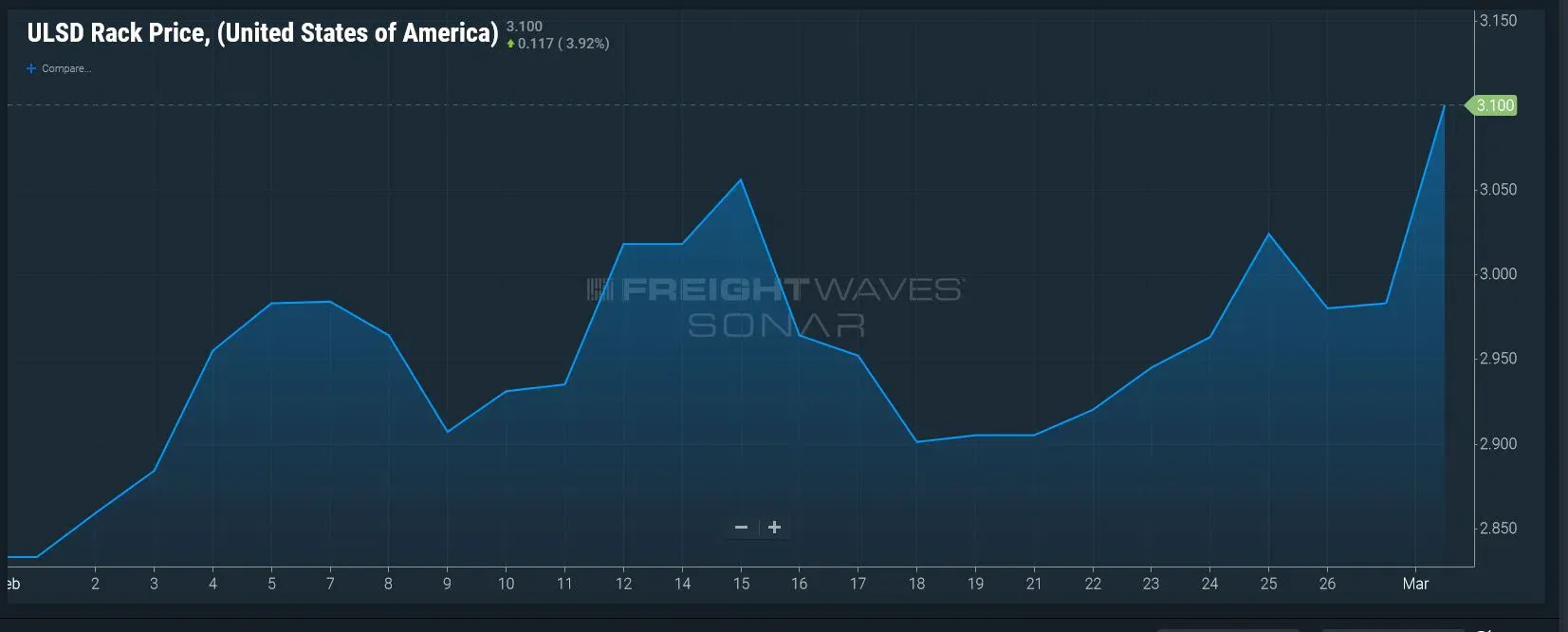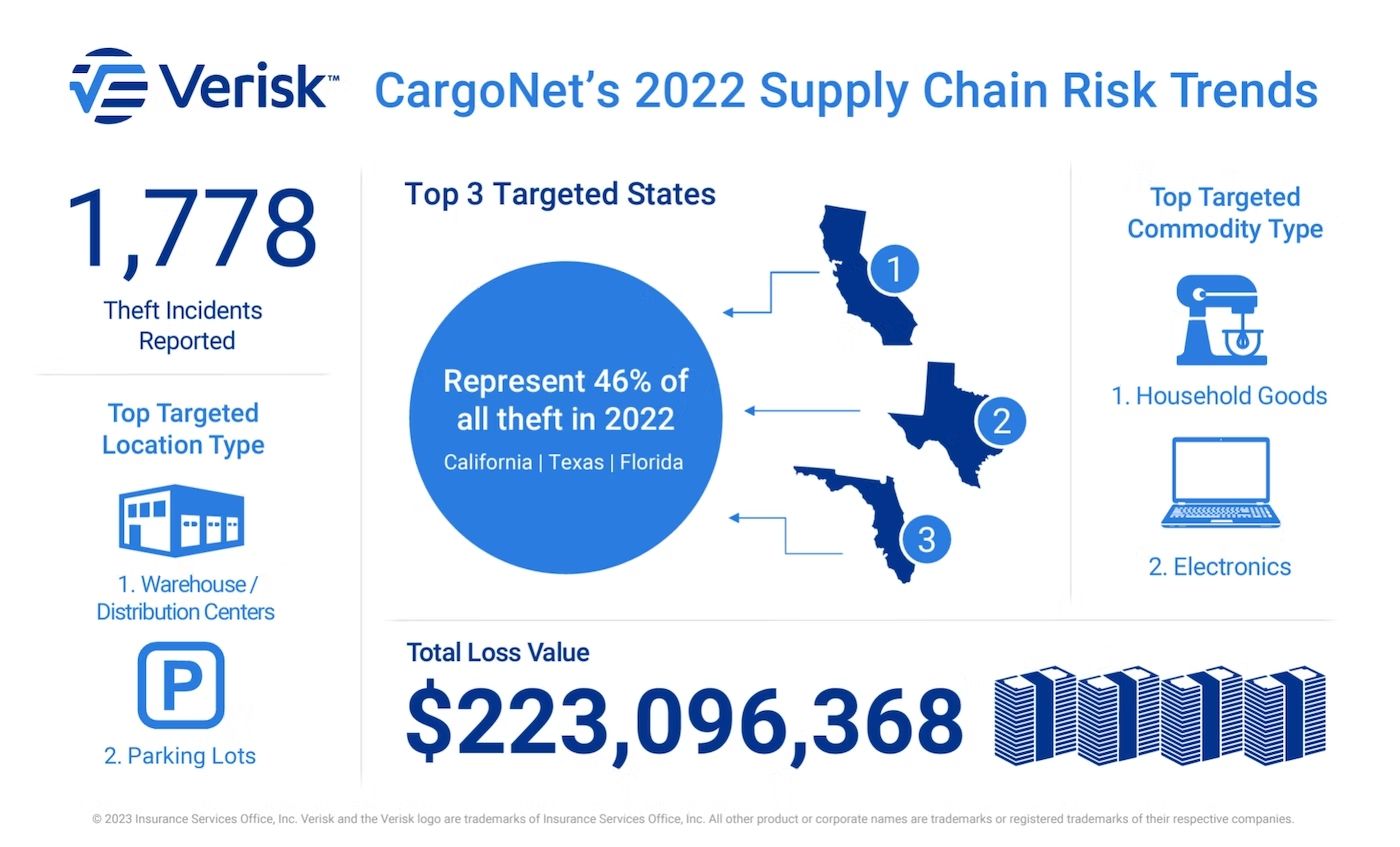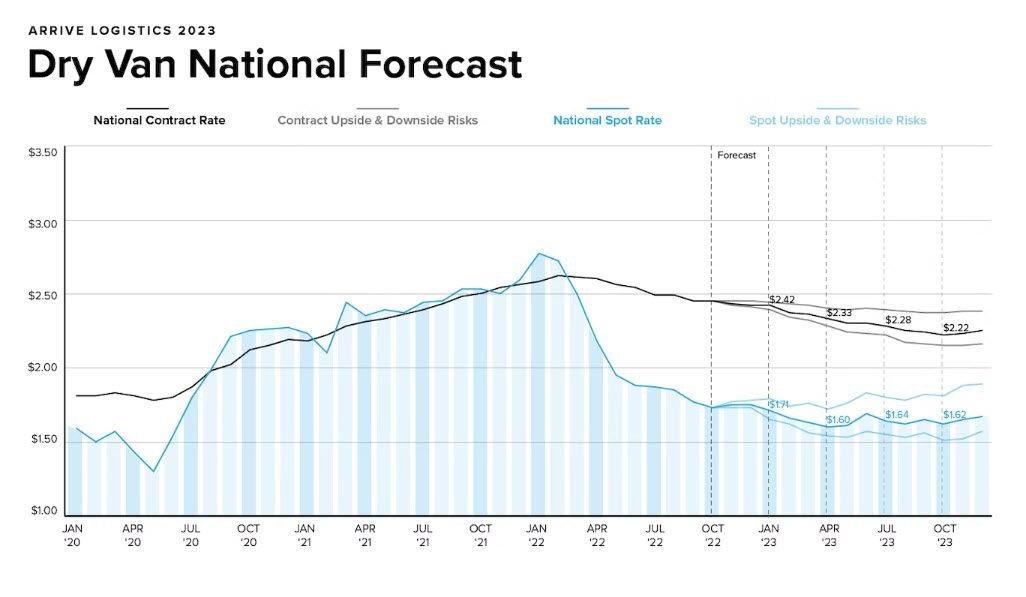Surging diesel prices, lag in fuel surcharges starting to raise concern
It’s a race: Will rates and surcharges keep up with rapidly rising price of diesel?
by: John Kingston

Diesel’s rapid rise is starting to create concerns that fuel surcharges and “all-in” prices for independent owner-operators may not be enough to stop fuel prices from becoming a significant headwind for the industry.
The price of ultra low sulfur diesel (ULSD) on the CME commodity exchange rose 21.98 cents a gallon Tuesday, settling at $3.1511 a gallon. The increase of almost 22 cents per gallon is the largest one-day jump since early June 2008. A review of the history of the ULSD contract — which had been a heating oil contract before morphing over time to become a diesel instrument — suggests Tuesday’s increase is possibly the second largest in the history of the contract after that move almost 14 years ago.
The March delivery contract “rolled off” Monday as February came to an end; the contract is traded for one month ahead of the calendar month. For example, in July, August barrels will be the front month.
March barrels settled Monday, the final day of the contract’s life, at $3.0134 a gallon.
Since the front month is used by oil companies setting wholesale prices as their starting point, that would mean the move between the front month Monday (when it was a March contract) and Tuesday (when it was an April contract) is a more moderate 13.77 cents a gallon, which might mean that wholesale increases won’t seek to capture the 20-cent-plus move. But even the 13.77-cent increase makes it one of only a handful of double-digit increases in the past 15 years.
National average wholesale diesel prices rose slightly less than 12 cents a gallon between Monday and Tuesday, according to the ULSDR.USA data feed in SONAR, changes that would not have reflected the soaring price from Tuesday. Wholesale diesel’s upward move was on the back of a more than 16-cent increase in the CME price Monday compared to Friday, though local market conditions also are a factor in setting wholesale prices.

What is beginning to concern some observers in the industry is that given the natural lag of fuel surcharges and spot rates that are negotiated with the goal of being high enough to capture fuel prices, individual owner-operators might find themselves way behind the rising prices at the pump.
Fuel surcharges collected by independent owner-operators are “probably not as widely used as they’d like to be used,” according to Lewie Pugh, an executive vice president with the Owner-Operator Independent Drivers Association.
Some independent owners might have fuel surcharges built into a contractual relationship with a regular customer, Pugh said. But many drivers are operating on an “all-in” price that they received from a broker or negotiated themselves. In the latter case, the assumption is that the driver would have agreed to a rate that would have covered a reasonable estimate on what fuel costs would be for a specific booking.
The problem, however, is that if retail prices at the pump are racing ahead, it could leave that all-in rate in the dust.
Additionally, a fuel surcharge in most cases would be updated weekly when the Department of Energy’s Energy Information Administration posts its weekly average retail price. That national average is usually the basis for surcharges, though California’s higher prices often lead to surcharges in the Golden State to be set on the DOE/EIA California price.
One industry analyst who requested anonymity said he is concerned that the numbers of new drivers who have launched their business to chase high trucking rates are doing so with older used trucks whose fuel efficiency is far from ideal. This analyst said fuel costs as a percentage of revenues are starting to push up toward levels that exceed 25%, a dangerous tipping point based on data from the past. He said when the rate begins to exceed that, bankruptcies start to pop up.
Ironically, the threat of high fuel costs pushing some companies into bankruptcy comes as a key indicator of the financial health of the trucking industry is showing positive numbers that are unprecedented.
David Roush, the president of KSM Transport Advisors, said there were serious perils for some of the newcomers to the market. “The statistics that show how new trucking firms are increasing while the average size is decreasing verifies what most legitimate truckers know. … [T]hey are chasing rates,” Roush said in an email to FreightWaves. “Many of these small firms have no customers and are 100% exposed to the spot market. They accept loads based on a flat charge; there is no fuel surcharge for them.”
Even when companies use a fuel surcharge, it is rarely simple. Roush pointed to a blog post he wrote eight years ago, in which he ticked off several types of surcharges: shipper standard FSC, PADD-specific FSC, Breakthrough Fuel, Zero Peg Fuel and an all-in rate, among others.
But Todd Amen, the president of trucking financial advisory firm ATBS, said the trucking market is so strong now that he believes carriers will be able to secure rates high enough to offset the rising cost of diesel. “We’ve never been in a market like this before, with this kind of power to pass those costs on,” he said.
Even with that power, Amen said there is a concern with liquidity: Can carriers get financing fast enough to pay for that diesel even if they also secure rates high enough to adequately cover the higher cost?
“It’s always a problem with surcharges,” Elaine Levin, the president at Powerhouse TL, which does fuel hedging and advisory, said of the situation facing drivers and fleets. “When prices really start to move, anything the EIA is reporting is a lagging indicator.”
Additionally, as she noted, “no one has a surcharge on 100% of everything they do,” Levin said. Her firm looks to calls in the commodity market as a principal method for hedging its clients’ fuel exposure.
A call is an option that gives the owner the right, but not the obligation, to buy a commodity at a designated price at a certain point in time. If the price of the commodity is more than that price, known as the strike price, the option expires unused. If the market price exceeds the strike price, then it would be exercised and fuel at a level less than the market could be secured through the option.
The factors that drove prices higher Tuesday were a continuation of what was in the market on Monday: concerns over the loss of 6 million to 7 million barrels per day of Russian petroleum supplies. Reports continued to pile up about companies refusing to do business with Russian oil suppliers, either as a buyer or a company servicing the selling of that product.
Aversion to Russian crude is strong enough that S&P Global Commodity Insights, which includes the Platts activities that assesses crude oil prices, assessed Urals crude out of Russia at $26 a barrel less than the dated Brent crude benchmark. On Jan. 25, that discount was $1.95 a barrel.











